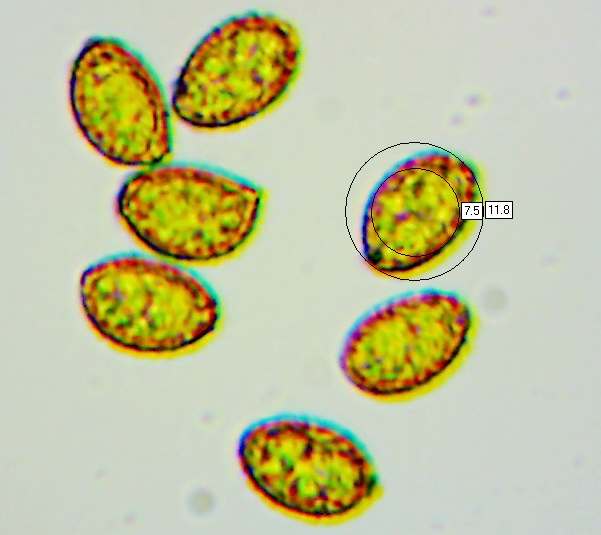Cortinarius violaceus (L.) Gray - Violet Webcap
Phylum: Basidiomycota - Class: Agaricomycetes - Order: Agaricales - Family: Cortinariaceae
Distribution - Taxonomic History - Etymology - Culinary Notes - Identification - Reference Sources
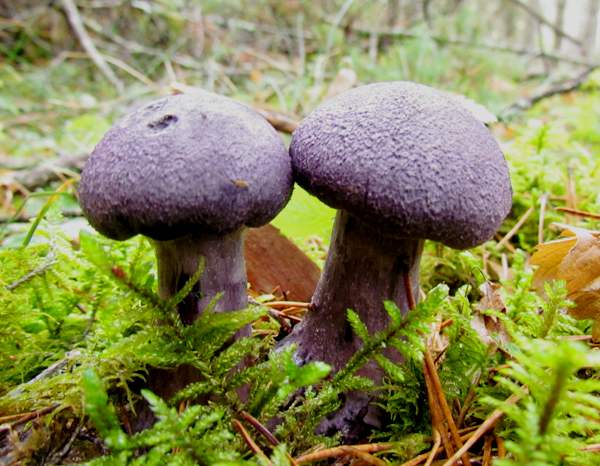
Cortinarius violaceus is entirely violet, purple or blue (sometimes so dark that it appears to be black and, viewed from above, can easily be mistaken for a blackened dead leaf). At up to 12cm in cap diameter, this is a very striking mushroom indeed.
It always comes as a great surprise to people who are not 'in to fungi' that mushrooms come in as many colours as do flowers. Blue and violet fungi come more as a shock than a mere surprise!
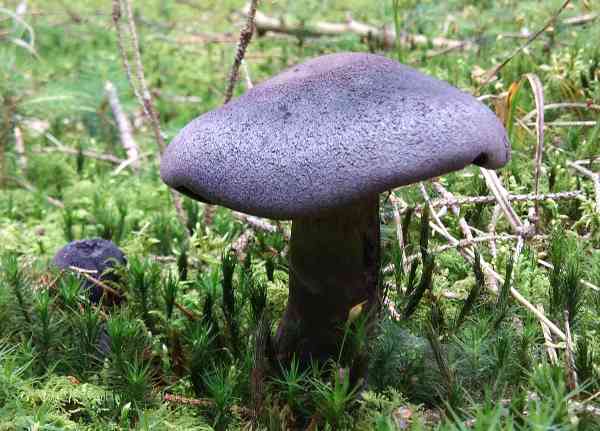
The lovely specimens shown above were photographed in central-southern France, in early October and were fruiting in small groups beneath pine trees but with silver birch trees nearby, making it impossible to determine in the field whether the fugi were mycorrhizally associated with one or other or indeed both of these tree species; however, in the detailed identification guide below you will see a photomicrograph of its spores, which are ellipsoidal, a characteristic of Violet Webcaps that are mycorrhizal with conifers.
Distribution
In Britain and Ireland, where it is a very rare find, the Violet Cortinarius grows in limestone and chalk-rich woodland habitats mainly under Beeches and other broadleaf trees but also very occasionally with conifers. This is a mushroom of late summer and autumn.
Taxonomic history
Described scientifically in 1755 by Carl Linnaeus, who called it Agaricus violaceus, the Violet Webcap was transferred to the genus Cortinarius in 1821 by the British mycologist Samuel Frederick Gray (1766 - 1828).
Some authorities split Cortinarius violaceus into two varieties: Cortinarius violaceus var. violaceus, which is mycorrhizal with broadleaf trees, and Cortinarius violaceus var. hercynicus, which forms mycorrhizae with conifers. The former has almond-shaped spores while the latter is distinguished by its ellipsoidal spores. (The picture shown above was taken in July 2009 in Southern Bavaria by Jochen Dahlke, with whose kind permission it is shown here.)
Cortinarius violaceus is the type species of the genus Cortinarius, which is the largest of the mushroom genera. Being violet, this webcap's colour is far from typical, as the majority of webcap species have fawn, orange or brown colouring. There are, however, other 'blue' webcaps including for example Cortinarius caerulescens.
Etymology
It hardly needs mentioning that the common name Violet Webcap comes from the colour of every part of this mushroom plus its web-like partial veil, or cortina, that spans the gap between stem and cap edge, thus covering the ripening fertile surfaces (the gills) of the mushroom. Similarly, the specific epithet violaceus is a direct reference to the colour of these beautiful mushrooms.
Identification guide
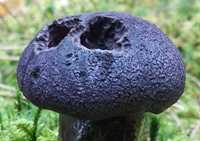 |
CapAt first hemispherical and later expanded with a slight umbo but often retaining an inrolled margin, the caps of this rare species are deep purple when young. The cap diameter of Cortinarius violaceus ranges from 6 to 12cm at maturity. |
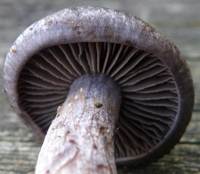 |
GillsThe adnate gills of the Violet Webcap are moderately spaced and purple when young. As the spores mature, the gills turn rusty brown and eventually they are stained dark by the spores. |
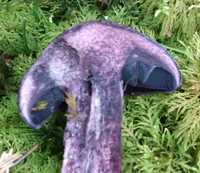 |
StemThe stipe or stem of the Violet Webcap is purple and fibrous with a slightly clavate (club-shaped) base. Typically 1 to 2cm in diameter, it can measure as much as 3 or 4cm across the base. The stem flesh - left - is also purple. |
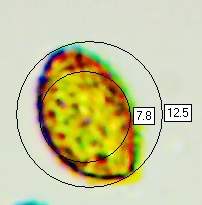 |
SporesEllipsoidal to amygdaliform (shaped like an almond), 11.5-14.5 x 7-9μm; thick-walled;somewhat ventricose (slightly swollen on one side); inamyloid. Spore printRusty brown. |
Odour/taste |
The cut flesh of Cortinarius violaceus smells slightly of cedarwood; it has no significant taste. |
Habitat & Ecological role |
This mycorrhizal mushroom is found in deciduous woodland and occasionally under conifers in alkaline (chalk and limestone) areas. |
Season |
July to November in Britain, usually fruiting earliest at higher altitudes. |
Occurrence |
Cortinarius violaceus is rare in Britain and Ireland but rather more common in some parts of mainland Europe, Asia, the Americas and in New Zealand and Australia. Distribution tends to be localised, and fruitbodies occur either singly or (more often) in small groups. |
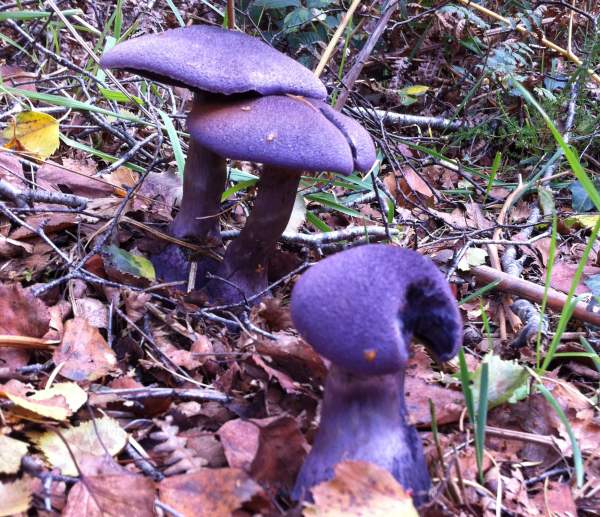
Culinary Notes
Although many authorities state that the Violet Webcap, Cortinarius violaceus, is a good edible mushroom, there are at least two sound reasons for not gathering this species. The first is its rarity: many seasoned forayers with decades of fungi hunting behind them have never seen this beautiful mushroom, and so unless a sample is required for detailed study its seems wrong to remove any from their natural habitat.
The second reason for shunning this and all other members of the genus Cortinarius is that quite a lot of them are seriously poisonous and a few have proven track records as deadly killers (Cortinarius rubellus and Cortinarius orellanus in particular contunue to take lives every year). If it has a cortina (cobweb-like veil) over the gills when young, my advice is not to try eating it. (The cortina of a Violet Webcap is quite fleeting, and mature specimens usually lose the partial veil.)
Reference Sources
Fascinated by Fungi, 2nd Edition, Pat O'Reilly 2016, reprinted by Coch-y-bonddu Books in 2022.
Funga Nordica, Henning Knudsen and Jan Vesterholt, 2008.
Dictionary of the Fungi; Paul M. Kirk, Paul F. Cannon, David W. Minter and J. A. Stalpers; CABI, 2008
Taxonomic history and synonym information on these pages is drawn from many sources but in particular from the British Mycological Society's GB Checklist of Fungi.
Acknowledgements
This page includes pictures kindly contributed by Lindsey Beasley and Jochen Dahle.
Fascinated by Fungi. Back by popular demand, Pat O'Reilly's best-selling 450-page hardback book is available now. The latest second edition was republished with a sparkling new cover design in September 2022 by Coch-y-Bonddu Books. Full details and copies are available from the publisher's online bookshop...
